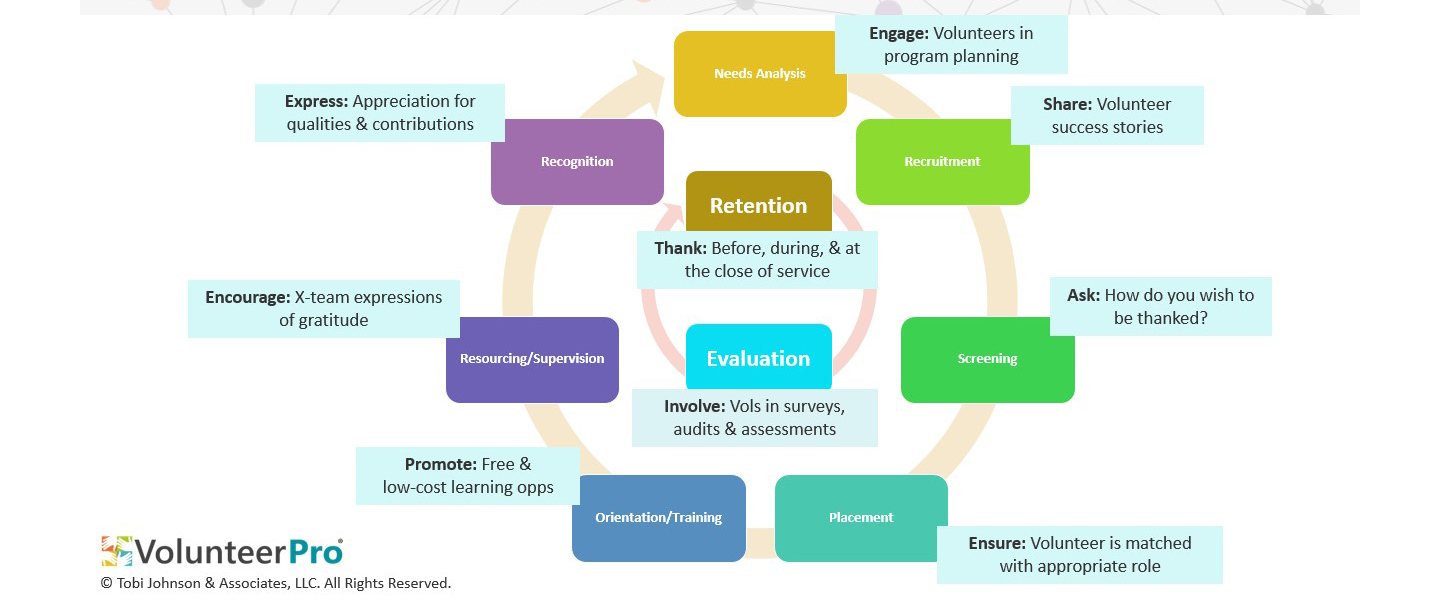 How to Appreciate Volunteers Through Every Lifecycle Stage
How to Appreciate Volunteers Through Every Lifecycle Stage
By now, you probably (hopefully!) are aware that April is the month that is set aside to appreciate volunteers.
There are a million and one ways to show appreciation for your volunteers during this designated season. If it snuck up on you this year, find some helpful ideas in this blog post, on this Pinterest board, and, of course, here at Tobi Johnson & Associates. (In case you have been caught unaware, you have a bit of wiggle room, as National Volunteer Week takes place April 18-24th, this year in the US and Canada.)
While we’re all about whatever brings recognition and demonstrates the value of volunteer work during this special month, we believe that, as volunteer-driven organizations, it’s our job to appreciate volunteers throughout the year (not just in April) and through every stage of the volunteer lifecycle.
In fact, we advocate a specific strategy to do just that.
What is 360° Volunteer Appreciation?
360° Volunteer Appreciation is a strategy that mixes formal and informal recognition activities to improve the overall volunteer experience.
By acknowledging progress made from onboarding through retention stages, a participant is rewarded at every step of their volunteer lifecycle. The ultimate goal is to strengthen relationships and deepen engagement of volunteers with your organization and your team.
You might be envisioning water bottles and tee-shirts flying out the door 24/7 at the thought of a continuous recognition program. That’s not what this is about, at all.
The goal is 1) acknowledge the contributions of volunteers to your mission in authentic ways and 2) the offer them something with meaningful value.
What your volunteers perceive as “value” may not be giveaways. Often, it’s deeper than that.
And it doesn’t always take more work.
Many methods of appreciation take the form of activities and even training that you may already be offering.
The difference may be in how you position these “perks.” Do volunteers feel they HAVE to do the training? Or do they believe they GET to participate in advancement opportunities?
The way you position your volunteer benefits can have a lot to do with how they are perceived.
“The highest reward for a person’s toil is not what
they get for it, but what
they become by it.” ~ John Ruskin
Key Drivers of Satisfaction
In our online Spotlight Course 360° Volunteer Appreciation, our students are taught ore strategic approach to volunteer recognition.
We encourage them to appreciate volunteers by first identifying key drivers of satisfaction for their team members and then focusing their recognition strategy on the specific top motivations of their team.
We warn students not to simply assume they know how your volunteers prefer to be acknowledged. Rather, once they’ve named your teams’ motivating factors, they’ll be better able to align reward activities that fit.
At its core, volunteer appreciation is about improving the volunteer’s experience and, in turn, their engagement. There are a few instances where material goods can serve this purpose – when they promote a sense of belonging or legacy.
However, real connectedness is supported by honoring and satisfying the volunteer’s emotional reason for their service.
In addition to volunteer-specific motivations, Science tells us that human motivations have changed over time. In today’s world, experts believe four key factors motivate us in the workplace, regardless of age or generational affiliation. They are:
Autonomy
- likes feeling self-directed
- values task, time, team & technique
Mastery
- likes making progress
- values challenges being matched to abilities
Relatedness
- likes using the technology of the time
- values connection with others
Purpose
- likes pursuing positive change on their own terms
- values when personal & organization goals are aligned
By now, you’re probably getting the picture — deeper volunteer engagement and greater retention isn’t going to happen because you give volunteers a coffee mug. It is going to happen because their volunteer experience has true meaning, and they feel empowered by it.
You can deepen satisfaction and commitment by offering recognition that cultivates autonomy, mastery, purpose, and relationships.
“Gratitude is a non-monetary way to support non-monetary motivations.” ~ Jeremy Adam Smith
Appreciate Volunteers According to Their Motivations
In addition to the four key factors of satisfaction in the workplace, research has identified six personal and social functions served specifically by volunteering.
In seeking to appreciate volunteers, build your strategy around the motivators that apply to your team members.
Values
- driven by a connection between organization’s mission and personal values
- seeks opportunities to meaningfully serve others
Career
- seeks opportunities providing specific skills development
- desires roles that facilitate advancement & networking
Social
- gravitates toward teambuilding & opportunities to socialize
- wants acknowledgement from highly respected peers
Understanding
- pursues professionalized in-service training & reflection
- prefers opportunities offering a variety of assignments to explore
Protective Motives
- craves assurance that their contributions have value
- gravitates to emotionally supportive settings
Enhancement
- aspires to opportunities promoting leadership development & power
- prefers that the experience be positive & upbeat
If you’re unsure how your volunteers would like to be recognized and rewarded, ask. In fact, asking for their input is one of the recognition tactics recommended, as doing so is, in itself, a way of showing that you value the person.
Incorporate the Strategy Throughout the Volunteer Lifecycle

As this graphic shows, there are opportunities for expressing appreciation at each stage of the volunteer’s engagement with your organization. By leveraging every chance to appreciation volunteers, you can see how it is seamlessly integrated through their entire experience.
We start with the asking, as mentioned above. Note how many of these you could incorporate in you program without buying a single material gift:
- When screening an applicant, ask how they wish to be thanked
- When deciding a volunteer’s placement, ensure they are matched with a role that suits their motivations.
- In orientation and training phases, promote free and low-cost learning opportunities.
- When supervising and making sure volunteers have all the resources they need, encourage cross-team expressions of gratitude.
- During recognition, express appreciation for the qualities of their work and the contribution they’ve made to the cause.
- In the planning and needs assessment phase, engage your volunteers in the process.
- During recruitment, share volunteer success stories.
- When it’s time for evaluation, involve volunteers in surveys, audits and assessments.
- For optimal retention, thank volunteers before, during and at the close of their service.
While tokens of appreciation may be a nice gesture, they aren’t likely to promote key drivers of behavior.
As busy staff, it’s important that everything you do help you efficiently move your mission forward. So, focus how you acknowledge volunteers in ways that really create meaning for volunteers.
The Power of Thanks and Gratitude
As you’ve seen, expressing appreciation consistently and in the right ways can improve the volunteer experience.
We shared in a recent blog post how there are benefits of gratitude that serve both the giver and receiver. And giving thanks lowers daily aggression, hurt feelings, and overall sensitivity. Gratitude increases the effectiveness of our decision making by increasing levels of patience. Simple expressions of gratitude directly affect productivity. There’s just no downside to expressing how much you appreciate volunteers!
Simple, authentic appreciation and specific praise is always more powerful than a t-shirt or coffee mug. So, why don’t we do it more often?
Maybe because we’re not sure how.
5 Keys to Authentic Praise
To offering authentic feedback, follow these pointers.
Make it:
- Timely – right when you observe great performance
- Specific – to the accomplishment (vs. a general “great job!”)
- Empathetic – acknowledging the sacrifice or effort it took
- Meaningful – linking it back to the mission
- Frequent – shown on a daily basis
Set yourself a week ‘gratitude quota’ for how many times you will say thank you to volunteers and co-workers. You may be surprised by the results.
Former Campbell Soup’s CEO, Doug Conant, famously sent his employees over 30,000 handwritten notes to amazing results. Employee engagement went up and, with it, their productivity. He was able to turn the company around through the power of praise.
It turns out people really do care that you are watching their progress and cheering them on.
Showing How You Appreciate Volunteers: Free Tools to Inspire
You are a lead volunteers, so you understand just how vital their work can be.
So, this post was probably preaching to the choir. We spoke about the ‘whys’ of volunteer recognition when you already know …
What you’re looking for, is HOW, right?
Well, we’ve got you covered there, too.
Below is a curated list of linked articles with tactical recommendations for showing appreciation, whether you’re virtual or in-person:
- This VolunteerPro blog post suggests ways to treat volunteers like the VIPs they are at your events, with tips for giving them the “velvet rope” experience!
- A whole chapter on volunteer appreciation from The Essential Guide to Managing Volunteers at Your Nonprofit
- Last, but not least, keep it pure and simple with our guide: How to Write the Perfect Volunteer Thank You Letter.
Appreciation may seem like an add on, something you do once a year during special celebrations.
But what if it were the single most important way to ensure happiness, productivity, and success of your volunteer efforts? What if it were an essential management strategy? How might you treat it differently?








Leave A Comment